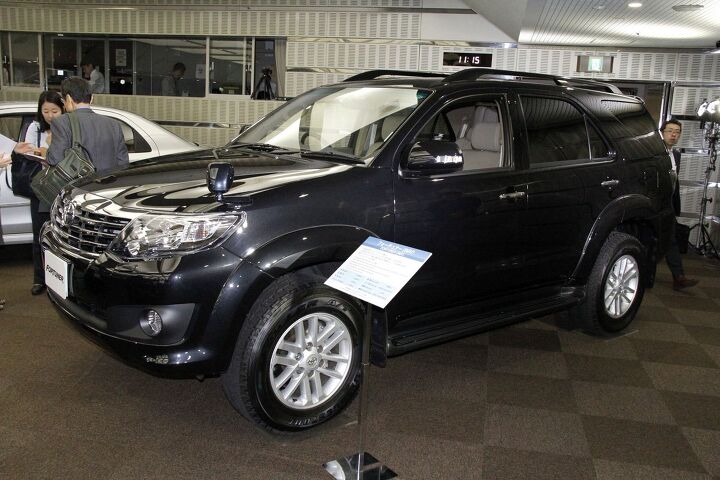Toyota Launches All-Out Assault On Emerging Markets, Meets "Fierce Competition" - Not From Detroit

Emerging market-san: Toyota's Yukitoshi Funo
If you are the executive of a car company, then you better be with both feet in the emerging markets, or seek other employment. Markets in the U.S., Europe and Japan are saturated and off their peaks. At the same time, people in the world’s most populous countries are trading in their mopeds for cars, and this is where you want to be. Sadly, Detroit appears to be underrepresented in these markets.
Toyota Executive Vice President Yukitoshi Funo today singled out Volkswagen, Hyundai, and Nissan/Renault as the companies that are in “fierce competition” with his employer when it comes to the growth markets of Asia and South America. A Detroit company was not mentioned.
Much to the chagrin of some patriotic Japanese reporters in the room, Funo said that Toyota’s production capacity in emerging markets skyrocketed from 450,000 units in 2008 to 3.1 million next year, which is “equivalent to our Japanese domestic production level.”
World car production currently stands at around 80 million units per year. Levels of 100 million or higher are expected soon. These cars, says Funo, will be “built where they are sold.” They will be built in emerging markets, not in the U.S., Europe or Japan. 45 percent of Toyota’s sales already are in emerging markets. Conservatively, the number is expected to climb to 50 percent by 2015.
Bolstered by the success of Toyota’s Etios, Toyota will launch eight new compact cars until 2015, designed for and built in emerging markets. Introduced in December 2010 in India, the Etios pierced the 100,000 mark in cumulative sales just a few days ago.
According to ample hints dropped today, the Etios platform will provide the underpinnings to the eight compact cars that will spearhead Toyota’s continued assault on the emerging markets. The cars will slot “below the Corolla and will have a size similar to the Etios,” said Managing Officer Kazuhiro Kobayashi, who promised that “the Etios platform naturally will be made good use of.”
This was then: Toyota's "wild cow", the 1976 Tamaraw
Toyota has big plans for these cars. They form what Toyota call the “new compact car category.” They are supposed to bring in sales of one million units per year before 2015.
This is now: Toyota Fortuner, a small SUV that is a hit in emerging marekts
They will not be low cost cars. Funo rejected rumors of a low cost car that would retail in the 500,000 yen ($6,300) category. Looking at a green Tamaraw, or “wild cow,” a very basic jeepney-type vehicle that led Toyota’s invasion of the Philippines in 1976, Funo said that times have changed:
“Customers in emerging markets no longer like the Tamaraw. They want to shift to better things, they want better and even better cars.”
Toyota wants to leave the low cost car segment to other makers, including its sibling Daihatsu. Toyota is focused on a price level around $12,000, which leaves room for families, bags, and aspirations.

Bertel Schmitt comes back to journalism after taking a 35 year break in advertising and marketing. He ran and owned advertising agencies in Duesseldorf, Germany, and New York City. Volkswagen A.G. was Bertel's most important corporate account. Schmitt's advertising and marketing career touched many corners of the industry with a special focus on automotive products and services. Since 2004, he lives in Japan and China with his wife <a href="http://www.tomokoandbertel.com"> Tomoko </a>. Bertel Schmitt is a founding board member of the <a href="http://www.offshoresuperseries.com"> Offshore Super Series </a>, an American offshore powerboat racing organization. He is co-owner of the racing team Typhoon.
More by Bertel Schmitt
Latest Car Reviews
Read moreLatest Product Reviews
Read moreRecent Comments
- Carson D Just don't be the whistleblower who reports on the falsification of safety data. That's a deadly profession.
- Carson D I'd have responded sooner, but my computer locked up and I had to reboot it.
- Todd In Canada Mazda has a 3 year bumper to bumper & 5 year unlimited mileage drivetrain warranty. Mazdas are a DIY dream of high school auto mechanics 101 easy to work on reliable simplicity. IMO the Mazda is way better looking.
- Tane94 Blue Mini, love Minis because it's total custom ordering and the S has the BMW turbo engine.
- AZFelix What could possibly go wrong with putting your life in the robotic hands of precision crafted and expertly programmed machinery?




































Comments
Join the conversation
GM's market share in China is much less impressive if you take out the 1 million + Wuling econovans -- a joint venture in which they only own a minority share. Take the Wulings out and GM's market share in China is declining.
Wuling's success is a direct result of GM management and technology, which grew Wuling from around 100,000/year when GM invested in the company in 2002 to well over 1,000,000 today. It is true that GM only owns 44% of the joint venture. http://www.autonews.com/article/20120131/BLOG15/120139981 It is also true that GM is NOT a leader in India, with about 4% market share.